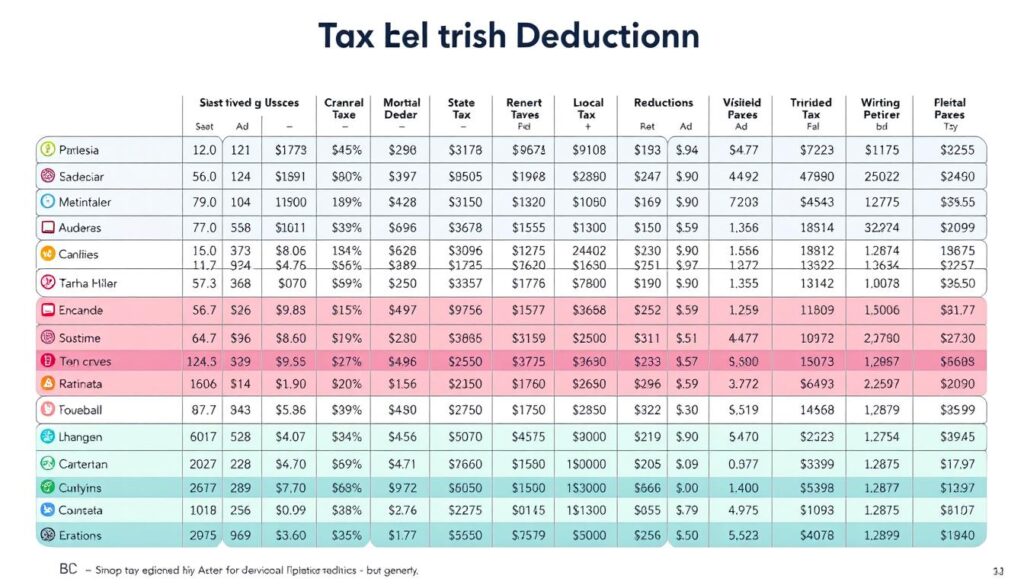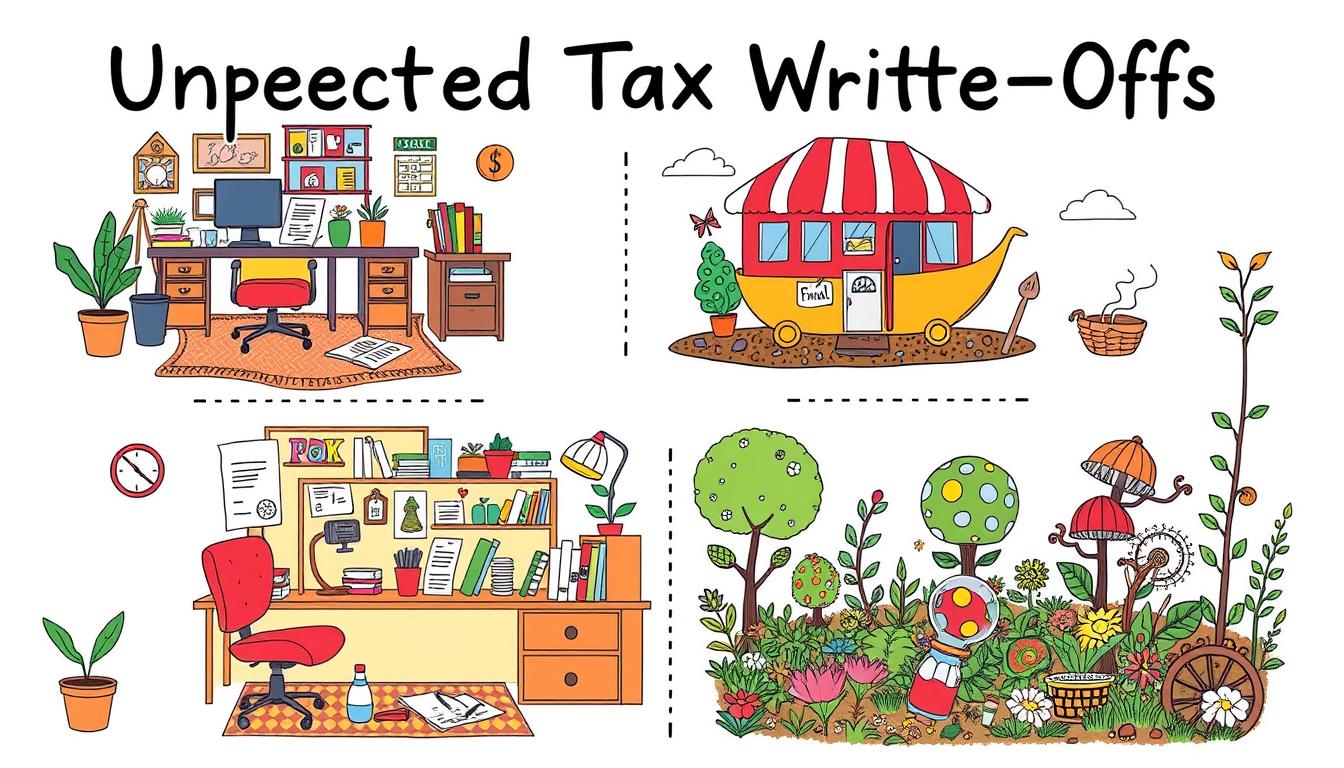Did you know that nearly 70% of Americans don’t claim important tax deductions each year? This fact shows many people might miss out on saving money during tax season. But, you’ve found the right spot to discover these overlooked tax breaks that could save you a lot of money.
Learning about these deductions and credits can help reduce your taxes and improve your finances.
Key Takeaways
- Many taxpayers overlook available hidden tax breaks.
- Understanding tax deductions can result in significant tax savings.
- Claiming credits like the Earned Income Tax Credit can aid low-to-moderate income individuals.
- Home office deductions may apply for those working from home.
- Charitable donations may qualify for additional tax credits.
- Investing in energy-efficient home improvements can offer tax benefits.
1
Introduction to Hidden Tax Breaks
Learning about tax breaks starts with knowing that many taxpayers miss hidden deductions. These can significantly lower their taxes. They include credits and benefits that aren’t obvious but can help your finances a lot.
When tax season comes, it’s key to recognize these tax saving strategies. Getting to know the different options helps you get all the deductions and credits you should. This not only makes things easier money-wise but also improves how you handle your taxes.
- Deductions for certain medical expenses: Many taxpayers overlook what qualifies.
- Educational expenses: You might be eligible for credits related to tuition and fees.
- Uncommon deductions: Items such as job-related expenses could be claimed.
Knowing about these chances can lead you to savings. Finding hidden tax deductions isn’t too hard. Get ready to look into these breaks for savings you hadn’t thought of. We’ll soon explore more about these tax benefits1.
Understanding Tax Breaks and Deductions
Knowing the different tax breaks available is key to better your finances. Tax breaks include tax deductions and credits. Tax deductions reduce your taxable income, which can lower your tax bill. This is helpful when you have many expenses you can deduct.
Tax credits, on the other hand, cut down the actual amount of tax you owe. Knowing the difference between breaks and deductions helps you save more money. Every tax year offers various tax breaks that might fit your situation.
Let’s dive into the main differences between tax deductions and credits:
| Aspect | Tax Deductions | Tax Credits |
|---|---|---|
| Effect on Taxable Income | Reduces taxable income | Reduces total tax liability |
| How They Work | Lower the amount of taxable income that is reported | Subtract directly from the total tax you owe |
| Common Examples | Mortgage interest, student loan interest | Child tax credit, earned income tax credit |
Understanding how tax breaks work is crucial. It helps you check if you’re eligible and ensure you’re saving as much as you can. Look carefully at your options. You might find big savings when tax time comes1.

You Could Qualify for the Earned Income Tax Credit
The Earned Income Tax Credit (EITC) provides a tax break for people with low to moderate income. By understanding this credit, you could save money and lower your taxes. Let’s explore the EITC and see if you might be eligible for it.
What is the Earned Income Tax Credit?
The Earned Income Tax Credit is aimed at low-income earners. Your income, filing status, and number of qualifying children determine the credit amount. The more children you have, the larger your credit could be. It can reduce the taxes you owe and may even give you a refund.
Eligibility Requirements for EITC
To be eligible for EITC, you need to meet certain conditions:
- You need income from a job or your own business.
- Your income must be below certain levels, which depend on how many children you have for the 2022 tax year.
- Your filing status cannot be married filing separately.
- A valid Social Security number is required.
- You must be a U.S. citizen or resident alien all year.
Don’t overlook these tax credits for low-income earners. They offer significant financial help. Be sure to check these guidelines to fully use your eligibility1.

Claiming Deductions for Home Office Expenses
If you are self-employed and work from home, you can get home office deductions. It’s important to know what counts as a home office. The IRS has clear rules for this write-off. Your office must only be for work and be your main place of business.
There are two ways to calculate these tax deductions:
- Simplified Method: This lets you deduct a set amount per square foot of your home office, up to a limit. It’s easier and needs less paperwork.
- Regular Method: This method calculates actual costs of your home office. This includes rent, utilities, and wear and tear. It might give you a bigger deduction but needs more records.
For the highest deductions, keep detailed records and receipts of all costs all year. The IRS provides guides and forms to accurately track these deductions.

| Method | Deduction Type | Pros | Cons |
|---|---|---|---|
| Simplified Method | Flat rate per square foot | Easy to calculate | Lower potential max deduction |
| Regular Method | Actual expenses | Higher potential max deduction | More complicated calculations |
Choosing wisely among home office deduction methods can greatly reduce your taxes. It makes working from home more rewarding1.
Utilizing State and Local Tax Deductions
Learning to use your state and local tax deductions can really help reduce your taxes. The State and Local Tax (SALT) deduction lets you deduct some taxes and lower your taxable income. We’ll explore the SALT deduction limits and how to get the most out of state and local tax deductions.
Understanding SALT Deduction Limits
The SALT deduction has a $10,000 cap for all taxpayers. This limit includes state and local income taxes, plus property taxes. Knowing this cap is key for planning your taxes. If you pay more than this in state and local taxes, you can’t deduct the excess.
Maximizing State and Local Taxes Deduction
Getting the most from your state and local tax deductions requires planning. Here are some strategies:
- Carefully track all applicable taxes: Make sure to record all payments for state income and property taxes, along with local taxes.
- Consider payment timing: If your taxes are near the $10,000 limit, think about when you pay. Paying some taxes early or changing how you pay might maximize deductions.
- Evaluate your options: Look at different state tax laws if you can choose where to live. This can affect your deductions.
- Utilize tax software or consult a professional: Tax software or a professional can help understand and maximize deductions.

| Type of Tax | Deductible Amount | Examples |
|---|---|---|
| State Income Tax | Up to $10,000 | Taxes withheld from paycheck |
| Local Income Tax | Included in $10,000 cap | City or county taxes |
| Property Tax | Included in $10,000 cap | Taxes on real estate |
By using these strategies, you can make the most of the SALT deductions. It’s vital to understand these limits to lower your federal taxes effectively1.
10 Hidden Tax Breaks Most Americans Miss Every Year!

Many Americans don’t take advantage of tax breaks they qualify for. These overlooked chances could save you a lot on taxes. Find out about ten hidden tax savings you might miss.
- Medical Expense Deductions: You can deduct medical expenses that are more than 7.5% of your adjusted gross income.
- Sales Tax Deduction: Deduct the state sales tax instead of state income tax. It’s beneficial if your state doesn’t have a state income tax.
- Educator Expenses: Teachers can write off up to $250 for classroom costs they pay for themselves. This adds up over time.
- State and Local Refunds: Your state tax refund may be taxable. This happens if you itemized your deductions the year before.
- Charitable Contributions of Goods: When you give items to charity, you can deduct their value from your taxes.
- Retirement Account Contributions: Putting money into traditional IRAs might lower your taxable income since those contributions can be deductible.
- Student Loan Interest Deduction: Deduct up to $2,500 in student loan interest. This is based on how much you earn.
- Qualified Business Income Deduction: Small business owners could deduct up to 20% of their income, which can lead to big savings.
- Moving Expenses for Active Duty Service Members: Active duty members can write off moving costs when they move for work.
- Filing Status Advantages: Choosing the right filing status, like head of household, offers lower taxes and higher deductions.
Learning about these untapped tax deductions could help you save more. Being aware of tax breaks Americans overlook means not missing out on savings. Talk to a tax expert to see if these savings apply to you. Often, it’s the small things that make a big difference at tax time1.
Taking Advantage of Medical Expense Deductions
Medical costs can pile up and strain your finances. Luckily, you might get some relief by deducting these costs on your taxes. Knowing which costs can be deducted is key to lowering your tax deductions for medical costs.
To deduct medical expenses, they must be more than a set part of your income. This rule is important for your tax plan. Be sure to keep all receipts and records. You can include many expenses, like:
- Prescription medications
- Hospital stays
- Doctor’s fees
- Health insurance premiums
- Long-term care services
Documenting these expenses well is vital for deductions. Organized records improve your chances of saving on taxes. Use spreadsheets or apps to track your spending.

Understanding medical expense deductions can make a big difference in your taxes. Every deduction counts toward your savings. Learn about tax deductions for medical costs. Stay updated on tax law changes that might help you save more1.
Educational Tax Credits You Might Overlook
Investing in your education brings financial rewards, including education tax credits. These credits can make tuition and other costs more manageable. This section covers the American Opportunity Tax Credit and the Lifetime Learning Credit. You’ll learn who qualifies and how to claim these benefits on your tax return.
The American Opportunity Tax Credit
The American Opportunity Tax Credit benefits students in their first four years of higher education. If you’re eligible, you can get up to $2,500 for each qualifying student. It’s valuable because it covers 100% of the first $2,000 in tuition and related expenses, plus 25% of the next $2,000.
- Eligibility: Full-time students in a degree program.
- Income Limits: Adjusted Gross Income (AGI) under $80,000 for singles, and $160,000 for married couples filing jointly.
- Application: To claim, use IRS Form 8863 with your tax return.
The Lifetime Learning Credit Explained
The Lifetime Learning Credit supports a wide range of educational activities. This includes courses to improve job skills. You can claim up to $2,000 per tax return, which is great for part-time and full-time students alike.
- Eligibility: Open to all students, no matter their enrollment status.
- Income Considerations: AGI must be below $59,000 for single filers and $118,000 for couples.
- Claiming the Credit: Like the American Opportunity Tax Credit, use IRS Form 8863.

Education tax credits help reduce the financial challenges of school expenses. Make sure you know each credit’s rules to save more during tax season. Keep track of your expenses through the year to take full advantage of these opportunities1.
Tax Breaks for Charitable Donations
If you make charitable contributions, you might get charitable donations tax deductions. It’s crucial to know which donations can be deducted. This includes cash gifts, property donations, and costs from volunteering. By using these tax breaks for philanthropy, you help organizations you care about. You also get benefits on your tax return.

To be eligible, keeping accurate records is a must. Let’s look at what you need for different types of donations:
- Cash donations: Always have a receipt or bank statement.
- Non-cash contributions: Document the item’s condition and its fair market value.
- Volunteer expenses: Keep track of any expenses you have while volunteering.
When you file your taxes, know the IRS rules for these deductions. Here are some key points to ensure you follow them:
- Check that the organization is a 501(c)(3) entity.
- Keep all receipts and records of your donations.
- Report the correct fair market value for items you don’t use anymore accurately.
Learning about charitable donations tax deductions helps you save more on taxes. These tax breaks for philanthropy not only benefit you but also impact others positively. Through these donations, you can make a real change in both your life and in others’1.
Tax Benefits for Child and Dependent Care
Working parents often juggle home and work responsibilities. Tax benefits like the child care tax credit help a lot. These credits lower the costs of caring for children or dependents. It’s important for parents to check their options.
The Child and Dependent Care Credit lets you claim costs for child care. This includes daycare, babysitters, and summer camps for kids under 13. To get this credit, your job situation and expenses matter.
- Eligible dependents must be under the age of 13 or physically or mentally incapable of self-care.
- Care must be provided so that you can work or actively look for work.
- Your income level affects the percentage of care expenses you can claim.
Keep good records of all care expenses. This helps when you file your taxes. Make sure to track all eligible costs to save more on taxes.

Knowing what expenses qualify and planning can maximize your benefits. This makes managing work and family finances easier. It supports parents in a big way.
To learn more, talk to a tax expert. They provide advice based on your needs and help you get all the tax benefits1.
Get Tax Credits for Energy-Efficient Home Improvements
Making your home better with energy-saving upgrades brings big rewards. This includes energy-efficient home credits and eco-friendly home tax deductions. You get money back and support a healthier planet too.
A lot of people don’t know which improvements give them tax credits. Key projects are:
- Installation of solar panels
- Energy-saving windows and doors
- High-efficiency heating and cooling systems
- Insulation improvements
Doing these updates can make your home use less energy. It also makes you eligible for big tax credits. For instance, solar panels can get you back 26% of the cost.
To get these perks, you need to keep track of everything you spend. Important papers include:
- Receipts for materials and labor
- Manufacturer certifications for products
- Proof of payment
Knowing and using these opportunities lets you upgrade your home and save on taxes. It’s a win for your budget and the earth.

Check how your home improvements can qualify. Every little bit helps save money and makes our planet healthier.
Start checking out these energy-efficient home credits. They lower your taxes and help the earth. Don’t miss this chance to make your home greener and keep more money in your pocket1!
Retirement Contributions and Hidden Tax Breaks
Adding money to your retirement accounts can really help your future money situation and your taxes now. You could get retirement tax credits and boost your savings with traditional IRAs, Roth IRAs, or 401(k)s. These help you save for later and also offer tax benefits now.
Traditional IRA contributions may lower your taxes today because you can deduct them from your taxable income. Roth IRA contributions don’t give you a tax break right away. However, you won’t pay taxes on money you take out later if you follow the rules. Knowing these details helps you use tax deductions for retirement savings in the best way.

| Retirement Account | Tax Advantages | Contribution Limits (2023) | Withdrawal Rules |
|---|---|---|---|
| Traditional IRA | Tax-deductible contributions | $6,500 (age | Taxed as ordinary income |
| Roth IRA | Tax-free growth and withdrawals | $6,500 (age | Withdrawals tax-free after age 59½ |
| 401(k) | Pre-tax contributions reduce taxable income | $22,500 (age | Taxed as ordinary income |
By filling up your IRA contributions and other retirement pots, you tap into tax benefits. This can mean paying less in taxes. Taking charge of your retirement money can really affect your future wealth and taxes today.
Planning your retirement smartly could reveal hidden tax breaks you didn’t know about. The key is to make your retirement plans work well with tax benefits. This aims to protect your money in the future1.
Simplifying Claims for Job-Related Expenses
Many employees may not know they can deduct job-related expenses on their taxes. Understanding deductible expenses can help you get some of your hard-earned money back. This includes uniforms, tools, and business travel, which can save you a lot at tax time.
When looking at how to simplify expense claims, keep these in mind:
- Uniforms and specialized clothing needed for your job.
- Tools and equipment you use for work.
- Travel costs for work, like mileage and hotels.
To not miss out on savings, it’s important to understand these categories. Keeping detailed records all year makes tax time easier. Here are the most common deductions related to work:
| Deductions | Description | Examples |
|---|---|---|
| Uniform Expenses | Cost of work clothes that you can’t wear as regular outfits. | Safety gear, work suits |
| Equipment and Tools | Tools and machines necessary for your job. | Computers, software, machinery |
| Travel Expenses | Costs for work trips beyond your usual commute. | Flight tickets, hotel bills, car rentals |
By understanding job-related tax deductions, you can boost your refund and reduce taxes owed. Being informed helps you make the best of your allowable expenses1.

Conclusion
Understanding tax breaks is crucial for savings many Americans miss out on. Learning about hidden deductions can significantly increase your savings. This helps you get a better tax outcome and boosts your financial health.
Think about how specific tax benefits apply to you. It might help to look at your past finances. This could reveal how to use these deductions in your plan. Every saved dollar matters, helping your financial future.
Being aware of tax breaks is empowering. This reminder emphasizes the importance of learning and claiming deductions. This effort can reveal savings you didn’t know existed. Don’t miss out on exploring these strategies1.








